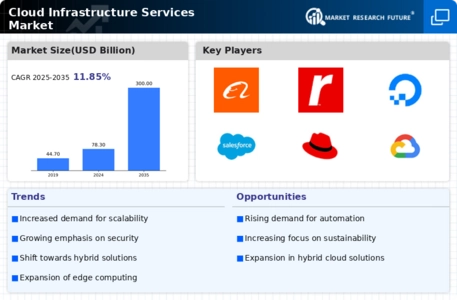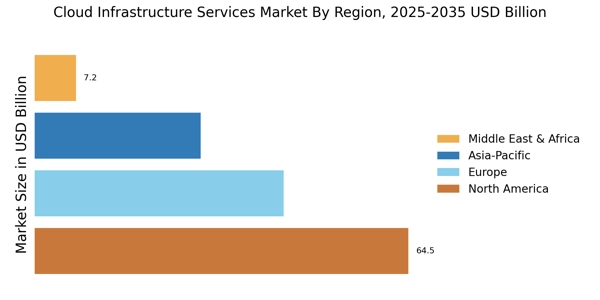North America : Cloud Innovation Leader
North America remains the largest market for cloud infrastructure services, holding approximately 45% of the global market share. The region's growth is driven by increasing demand for scalable solutions, regulatory support for digital transformation, and a robust technological ecosystem. The U.S. government has been a significant catalyst, promoting cloud adoption through various initiatives and funding programs.
The competitive landscape is dominated by major players such as Amazon Web Services, Microsoft Azure, and Google Cloud, which continue to innovate and expand their offerings. The presence of these key players fosters a vibrant market, encouraging startups and smaller firms to enter the space. The U.S. and Canada are the leading countries, with substantial investments in cloud infrastructure and services, further solidifying North America's position as a global leader.
Europe : Emerging Cloud Market
Europe is witnessing rapid growth in the cloud infrastructure services market, accounting for approximately 30% of the global share. The region's growth is fueled by stringent data protection regulations, such as GDPR, which encourage businesses to adopt cloud solutions for compliance. Additionally, the European Union's Digital Single Market strategy aims to enhance digital connectivity and cloud adoption across member states, further driving demand.
Leading countries in this region include Germany, the UK, and France, which are home to several key players like SAP and OVHcloud. The competitive landscape is characterized by a mix of established firms and innovative startups, all vying for market share. The presence of major global players, alongside local firms, creates a dynamic environment that fosters competition and innovation in cloud services.
Asia-Pacific : Rapidly Growing Cloud Hub
Asia-Pacific is emerging as a powerhouse in the cloud infrastructure services market, holding around 20% of the global market share. The region's growth is driven by increasing internet penetration, a burgeoning digital economy, and government initiatives promoting cloud adoption. Countries like China and India are at the forefront, with significant investments in cloud infrastructure to support their growing tech ecosystems.
China, led by Alibaba Cloud and Tencent Cloud, is a key player in the region, while India is rapidly catching up with its own cloud service providers. The competitive landscape is diverse, with both local and international firms competing for market share. The region's unique challenges, such as regulatory hurdles and varying levels of digital maturity, create opportunities for innovation and tailored solutions in cloud services.
Middle East and Africa : Emerging Cloud Frontier
The Middle East and Africa region is witnessing a gradual but significant growth in cloud infrastructure services, accounting for about 5% of the global market share. The growth is driven by increasing investments in digital transformation, government initiatives to enhance ICT infrastructure, and a rising demand for cloud solutions among businesses. Countries like the UAE and South Africa are leading the charge, supported by favorable regulatory environments and strategic investments in technology.
The competitive landscape is characterized by a mix of local and international players, with firms like Microsoft and AWS establishing a strong presence. The region's unique challenges, including varying levels of infrastructure development and regulatory frameworks, present both challenges and opportunities for cloud service providers. As businesses increasingly recognize the benefits of cloud adoption, the market is poised for further growth.

















